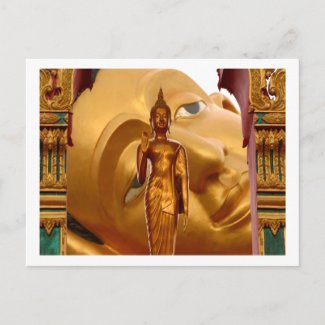Buddha Thailand Peace Tranquility Serenity Postcards from Zazzle.com
Zazzle O Vision
Tuesday, August 10, 2010
Monday, July 12, 2010
History of Postcards
Sending postcards through the mail service did not suddenly appear, it has evolved over one hundred years. Many early innovations in the postal system helped create this new postcard age. One of the most important innovation was the introduction of uniform penny postage in Great Britain in 1840 that made mail delivery easy and affordable. Before this standardization, prices for sending letters was based on the distance the mailman had to travel to make the delivery. Fees were not collected up-front from the sender, but instead a surprised recipient would find a mailman on the doorstep, demanding payment. Post offices had been loosing ghastly amounts of money through this system, for recipients would often refuse their mail and the postman would be sent away unpaid. In 1837 Rowland Hill suggested that letters be charged by weight, rather than distance, and the fee would be collected from the sender in advance. This new procedure guaranteed the postman would be paid for delivery services and soon transformed the postal system.
Austria was the first country to actually publish the postcard, but Austria was not the first to develop the idea. A few years earlier, German postal official Dr. Heinrich von Stephan submitted a proposal for such a postcard prototype, which was fiercely debated and not executed in Germany until July 1870, a year after Austria introduced the card to their countries postal system. Within two years, the postcard had become so popular it quickly spread across Europe. The United States did not officially introduce postcards until 1873, two years after Canada and three years after most European countries, but unlike these countries, stamped cards had been allowed in American mail since 1861. In 1875, delegates from 22 countries met in Switzerland as the General Postal Union and upon aggrement they established a standardized postage rate and government issued card to be exchanged between countries in the union members; four years later they renamed themselves the Universal Postal Union.
In the nineteenth century, with the increasing popularity of postcards, printing technology quickly advanced with German and Parisian publishers experimenting with special edition postcard sets by the most sought after artists of the time. In Great Britain, artistic innovations in postcard design were slowed by the British postal authorities’ ban on larger-dimensioned cards, whose measurements were standard in most European countries in the Universal Postal Union.
Postcards continued to grow in popularity in the early 1900s as they were a way to send friends and family a snapshot of one’s travels and surroundings, natural and man-made disasters, risque pinup girls, automobile, ships, trains, airplanes, famous landmarks and even photographs of one’s home.
Austria was the first country to actually publish the postcard, but Austria was not the first to develop the idea. A few years earlier, German postal official Dr. Heinrich von Stephan submitted a proposal for such a postcard prototype, which was fiercely debated and not executed in Germany until July 1870, a year after Austria introduced the card to their countries postal system. Within two years, the postcard had become so popular it quickly spread across Europe. The United States did not officially introduce postcards until 1873, two years after Canada and three years after most European countries, but unlike these countries, stamped cards had been allowed in American mail since 1861. In 1875, delegates from 22 countries met in Switzerland as the General Postal Union and upon aggrement they established a standardized postage rate and government issued card to be exchanged between countries in the union members; four years later they renamed themselves the Universal Postal Union.
Look for a personalized gift at Zazzle.
In the nineteenth century, with the increasing popularity of postcards, printing technology quickly advanced with German and Parisian publishers experimenting with special edition postcard sets by the most sought after artists of the time. In Great Britain, artistic innovations in postcard design were slowed by the British postal authorities’ ban on larger-dimensioned cards, whose measurements were standard in most European countries in the Universal Postal Union.
Postcards continued to grow in popularity in the early 1900s as they were a way to send friends and family a snapshot of one’s travels and surroundings, natural and man-made disasters, risque pinup girls, automobile, ships, trains, airplanes, famous landmarks and even photographs of one’s home.
Subscribe to:
Posts (Atom)


